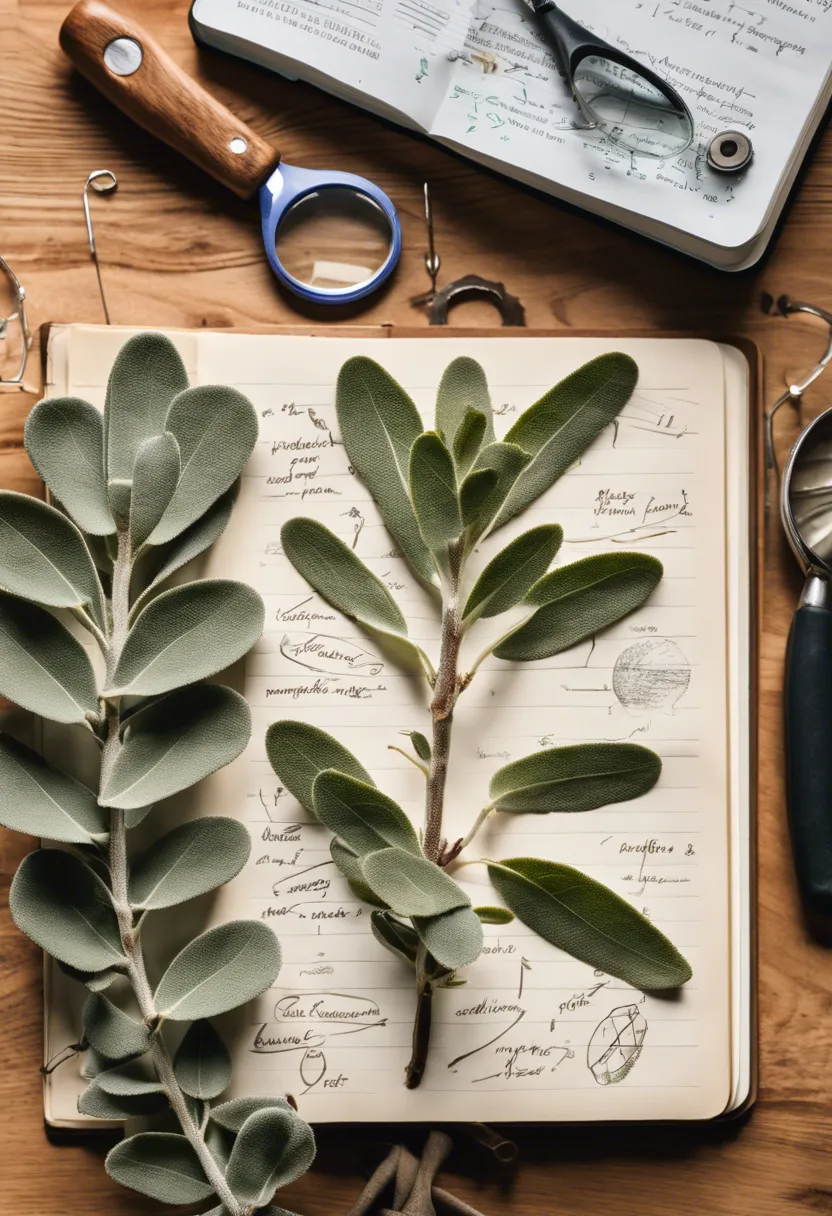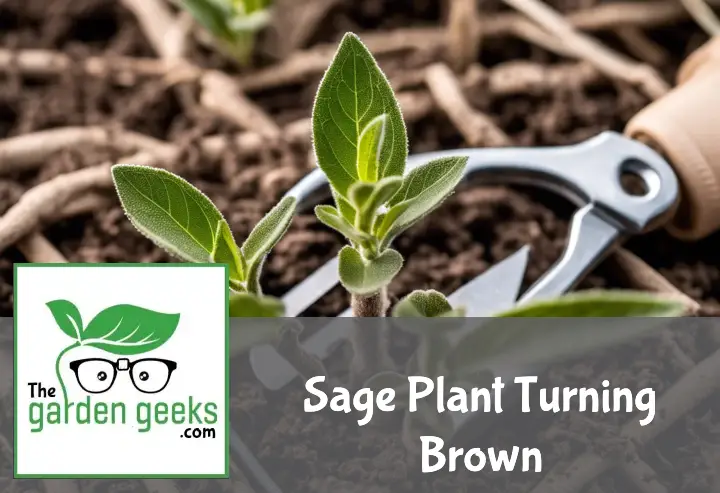Ever noticed your Sage Plant Turning Brown? Don’t panic just yet. It might seem like a disaster, but it’s a common issue that can be tackled with a little know-how.
In this post, we’ll dissect the problem and provide solutions to get your sage back to its vibrant green self.
Grab your gardening gloves, and keep reading about Sage Plant Turning Brown.
Key Takeaways
- Your sage plant turning brown could be due to overwatering, lack of sunlight, or a disease like root rot.
- To fix it, first check the watering schedule. Sage plants prefer dry conditions, so cut back on watering if you’re doing it too often.
- Ensure your sage is getting enough sunlight – at least 6 hours a day.
- If these don’t work, your plant might have root rot. In this case, remove the diseased parts and repot the plant in fresh soil.

Understanding the Problem: Why is My Sage Plant Turning Brown?
If you’ve noticed your sage plant turning brown, you’re probably wondering what went wrong. This issue can stem from a variety of causes ranging from environmental factors to pests and diseases. Let’s dive into what might be causing your sage plant problems and how to identify them.
Identifying Symptoms of a Dying Sage Plant
When it comes to recognizing an unhealthy sage, there are several signs you should look out for beyond just browning sage leaves. Initially, you might notice that the vibrant green color of the leaves starts fading, turning into a dull, lifeless brown. But let’s not jump to conclusions too quickly; some leaf discoloration is normal as leaves age. However, if this discoloration spreads rapidly or affects new growth, it’s a red flag.
Another indicator of distress is when leaves start dropping off without any apparent reason or if the plant stops growing altogether. Additionally, check for any unusual spots or marks on the leaves which could suggest pest infestation or disease. These symptoms combined can give you a clearer picture of your sage plant’s health and whether it’s just going through a rough patch or facing something more serious.
Common Causes for Browning in Sage Plants
Diving deeper into why your sage might be looking more like autumn foliage than a vibrant herb, let’s explore some common culprits. Overwatering is often at the top of the list; too much water can lead to root rot, depriving the plant of essential nutrients and leading to browning leaves. On the flip side, underwatering can stress your plant out just as much.
Pests such as spider mites and aphids see your sage as an all-you-can-eat buffet, sucking out vital juices and leaving behind damaged, browning foliage. Diseases like powdery mildew also take their toll on sage plants by coating leaves in a white film before they eventually brown and die.
Nutrient deficiencies shouldn’t be overlooked either. A lack of essential nutrients like nitrogen can impair your sage’s ability to photosynthesize properly, leading to weakened growth and discolored leaves. Each of these factors disrupts the delicate balance required for healthy growth but identifying which one is affecting your plant is key to saving it.
The Impact of Environmental Factors on Sage Health
Last but not least, don’t underestimate the power of Mother Nature in influencing your sage plant turning brown saga. Too much direct sunlight can scorch leaves while too little will stunt growth and promote disease. Similarly, extreme temperature fluctuations challenge even the hardiest plants; cold snaps can damage cell structure while excessive heat stresses plants out.
Humidity plays its part too – high humidity levels create an ideal breeding ground for fungal diseases whereas low humidity can dry out soil too quickly. Creating an optimal environment involves striking a balance: enough sunlight without scorching exposure, moderate temperatures without wild swings, and consistent watering based on weather conditions rather than a strict schedule.
By understanding these environmental factors and adjusting care accordingly, you’re setting up your sage (and other herbs) for success in any garden or windowsill setup.
Diagnosing the Issue: What’s Wrong with My Sage Plant?
If your sage plant turning brown has you scratching your head, you’re not alone. Let’s dive into the common culprits and get to the bottom of this garden mystery.
Overwatering and Root Rot
Ah, water – it’s a life-giver but can also be a life-taker for sage plants. Overwatering is like throwing a pool party in your sage plant’s roots that they never asked for. This soggy situation leads to root rot, a nasty condition where the roots start decaying. Overwatering symptoms include leaves turning yellow or brown and wilting, despite the soil being wet.
Now, if you suspect root rot, don’t panic! First, cut back on watering and improve drainage around your plant. Consider repotting with fresh soil if the situation looks dire. Root rot treatment often involves removing affected roots before they spoil the bunch. Remember, sage plants prefer a dry humor and even drier soil.
Underwatering and Dehydration
On the flip side, underwatering turns your sage plant into a desert dweller without the resilience of a cactus. Signs of underwatering are droopy leaves that may turn crispy brown at their tips or edges. The soil will feel as dry as sand in an old Western movie.
The trick is finding that Goldilocks zone of watering – not too much, not too little. Aim for consistently moist (not wet) soil by checking with your finger; if the top inch is dry, it’s time to water. Preventing dehydration in plants starts with understanding their needs and adjusting your watering schedule accordingly.
Nutrient Deficiency or Excess
Nutrients are like vitamins for plants; too little or too much can lead to problems. A nutrient deficiency in sage might show up as pale or yellow leaves, while excess nutrients can cause leaf burn or inhibit water uptake.
To strike the right balance, use a balanced fertilizer designed for herbs but go easy on it; more isn’t always better. If you suspect an imbalance, testing your soil can be insightful. Correcting soil nutrients might involve adding compost (for deficiency) or leaching the soil with water (for excess).
Disease and Pest Infestation
Lastly, diseases and pests love crashing the sage party uninvited. Common signs include spots on leaves, distorted growth, or unwelcome guests like aphids and spider mites making themselves at home.
For diseases like powdery mildew or rust, ensure good air circulation around your plants and avoid overhead watering to keep leaves dry. For pests,* pest control in herbs* often starts with natural predators like ladybugs or neem oil treatments for gentler solutions before escalating to chemical warfare.
Remember: Prevention is key! Regularly inspecting your plants for early signs of trouble can save you from bigger headaches down the road.



Step-by-Step: How to Revive a Brown Sage Plant


So, your sage plant is looking more like a sad, brown mess than the lush, green herb you were hoping for. Don’t throw in the trowel just yet! With a bit of TLC and some straightforward steps, you can attempt to bring your sage plant back from the brink. Let’s roll up our sleeves and get to it.
-
Assess the damage first. Take a close look at your sage plant. If it’s completely brown and crispy, it might be too late. However, if there are some green parts left, there’s hope! Focus on those.
-
Trim away the dead stuff. Using clean scissors or pruning shears, cut off all the brown and dead leaves and stems. This might feel like you’re giving your plant a drastic haircut, but it’s necessary to help it focus its energy on new growth.
-
Check the soil moisture. Sage plants don’t like wet feet! Stick your finger into the soil; if it feels soggy or very wet, you might be overwatering. Let the soil dry out before watering again.
-
Water wisely from now on. When you do water, do so deeply but infrequently, allowing the top inch of soil to dry out between waterings. This encourages deep root growth and helps prevent future browning.
-
Move your plant if needed. Sage loves sunlight – about 6 to 8 hours of direct light daily is ideal. If your plant isn’t getting enough light, consider moving it to a sunnier spot.
-
Feed your sage sparingly with a balanced fertilizer but only after it shows signs of new growth. Over-fertilizing can stress an already stressed plant!
-
Monitor for pests and diseases since these can also cause browning leaves in sage plants—common culprits include spider mites and fungal infections.
By following these steps carefully and patiently waiting for results (plants take their sweet time!), you’ll give your sage plant its best shot at recovery and hopefully see new green growth soon.
Preventive Measures for Healthy Sage Growth
Alright, so you’ve noticed your sage plant looking a bit like it’s auditioning for a role in “The Plants of the Living Dead.” Don’t fret! The key to avoiding this horror movie scenario lies in some simple preventive measures. Let’s dive into the nitty-gritty of keeping your sage happy, healthy, and decidedly un-zombie-like.
-
Choose the right spot: Sage loves the sun more than a cat loves a warm windowsill. Make sure it gets at least 6 to 8 hours of direct sunlight each day. A spot that’s too shady will make your sage as unhappy as a vampire on a beach.
-
Water wisely: Overwatering is like giving your plant an unwanted bath. Sage prefers its soil on the dry side, so let the top inch or so dry out before giving it another drink. Think of it as waiting for permission rather than assuming it’s thirsty.
-
Improve drainage: If water in your sage pot sits longer than guests after a dinner party, you’ve got a problem. Mix sand or perlite into your potting soil to make sure water drains faster than teenagers leaving an awkward family gathering.
-
Prune regularly: Pruning is like giving your plant a good haircut; it encourages growth and prevents diseases. Trim back about one-third of the growth every now and then to keep your sage bushy and healthy, not spindly and sad.
-
Watch for pests: Keep an eye out for freeloaders like aphids and spider mites that love to crash the sage party. If you spot them, gently wash them away with water or use insecticidal soap as a bouncer to show them the door.
-
Fertilize sparingly: Sage isn’t greedy; it doesn’t need much food. Over-fertilizing can lead to weak growth and less flavorful leaves. A light feeding in spring is usually all it needs to keep from going on strike.
Remember, prevention is better than cure—especially when dealing with plants since they can’t exactly tell you when something’s wrong until it’s possibly too late!


To Wrap Up
So, your Sage Plant Turning Brown had you worried, huh? We’ve covered a lot today – from overwatering to lack of sunlight and pest infestations. Remember, these are common issues that can be easily rectified.
Next time your sage goes a bit brown, don’t panic! Check the watering schedule, light exposure and look for any creepy crawlies.
Finally, remember that plants need love too. Pay attention to their needs and they’ll reward you with lush green leaves in no time!


